|
|
|
Sort Order |
|
|
|
Items / Page
|
|
|
|
|
|
|
| Srl | Item |
| 1 |
ID:
184779
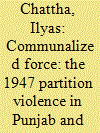

|
|
|
|
|
| Summary/Abstract |
The communalization of the police, which resulted from the embittered political situation among the rival communities, was a prominent feature of the Partition violence in 1947. Instead of safeguarding minority communities under attack, the police largely condoned and contributed to the violence, not because of sympathies with their coreligionists, but because they could act with impunity in an environment of insubordination and administrative breakdown in the process of the transition of power of the outgoing British colonial state. This article will show that the absence of a restraining authority, impunity from the law at the point of transitional state-created conditions of violence and the participation of law enforcement agencies led to the widespread violence. This documentation is done by accessing previously unexplored police First Information Reports (FIRs) lodged at local police stations at the time, and the reports of the Punjab Special Branch Intelligence Police from the Roberts Club Archives (RCA), Lahore. The analysis not only contributes to recent scholarship that focuses on the ‘new history’ of Partition studies but also provides an intriguing insight into the role of law enforcement agencies in mass violence.
|
|
|
|
|
|
|
|
|
|
|
|
|
|
|
|
| 2 |
ID:
118910
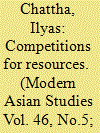

|
|
|
|
|
| Publication |
2012.
|
| Summary/Abstract |
This paper explores the part that the redistribution of evacuee property-the property abandoned by departing Hindus and Sikhs during the mass migrations after Partition-played in the institutionalization of corruption in Pakistan. By drawing on hitherto unexplored sources, including Pakistan's Rehabilitation Department papers, local police files and court records, it highlights the schemes of illegal appropriation, misappropriation, and paints a wholly convincing portrait of the scramble for millions of rupees worth of abandoned property in the towns and countryside of West Punjab. It shows how politicians, bureaucrats, powerful local notables and enterprising refugee groups grabbed properties, mainly by bribing officers charged with allocating them to incoming refugees, or by utilizing their personal contacts. The paper argues that the fierce competition for resources and temptations for evacuee property encouraged the emergence of a 'corruption' discourse which not only contributed to an atmosphere that was detrimental to democratic consolidation in the early years of Pakistan's history, but also justified later military intervention. This not only adds to the empirical knowledge of Partition and its legacies, but also makes a significant contribution towards our understanding of the transitional state in Pakistan.
|
|
|
|
|
|
|
|
|
|
|
|
|
|
|
|
| 3 |
ID:
133096
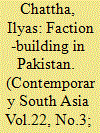

|
|
|
|
|
| Publication |
2014.
|
| Summary/Abstract |
This essay provides new evidence on local Pakistani politics in the immediate post-independence period. It reveals that far from being a period of national unity and service to the fledgling state, the country was mired in faction-building strategies between political rivals, competing for power and scrambling for resources, with debilitating consequences for democratic consolidation. While the new sources - largely based upon the archival records deposited at the National Documentation Centre, Islamabad - provide material relating primarily to Punjab, this essay demonstrates that the tensions between central government and the provinces can only be comprehended by reference to studies of localities.
|
|
|
|
|
|
|
|
|
|
|
|
|
|
|
|
| 4 |
ID:
182851
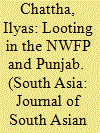

|
|
|
|
|
| Summary/Abstract |
According to Police Special Branch intelligence reports, amidst the chaos of Partition, over 60,000 ounces of gold were stolen from fleeing Hindus and Sikhs in 1947. Alongside political identity and religious organisation and territorialisation, desire for wealth or property was a key trigger for the continuation of the Partition violence. This article documents organised communal violence which erupted in the NWFP and Punjab during 1946–47 using largely underutilised police and intelligence reports from the period. The empirical focus of the article is two-fold. First, to show that the intercommunity violence triggered in these provinces was organised and funded by the Muslim League through its volunteer wings, even if specific perpetrators were locals. Second, that looting was a feature of locally-rooted violence to acquire property owned by non-Muslim minorities. As well, individual motives for revenge or a desire to best one’s business rival fuelled the violence alongside ideological imperatives such as the commitment to the idea of Pakistan.
|
|
|
|
|
|
|
|
|
|
|
|
|
|
|
|
| 5 |
ID:
126171
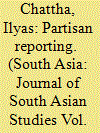

|
|
|
|
|
| Publication |
2013.
|
| Summary/Abstract |
This study analyses the press reporting in India and Pakistan of Partition-related violence in 1947 and the unsuccessful attempts by the colonial authorities to censor provocative accounts in a context of administrative collapse. Assessing the extent of bias exhibited by the coverage, the study highlights the respective roles of the press and of rumours in spreading 'news' of the violence and so contributing to its cycle. The focus is on the tactics of all the sides involved which were designed to attribute responsibility to a hostile 'other', while playing down each community's involvement in violence as merely defensive. The study presents a modest contribution to the wider notion of the role of 'blame displacement' in reporting violence and the inability of what might be termed the transitional colonial state to control the press amid a general decline in governance.
|
|
|
|
|
|
|
|
|
|
|
|
|
|
|
|
|
|
|
|
|